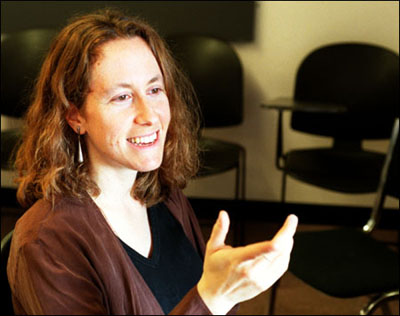GSE’s Pollock explores ‘colormuteness’ in American education
How we fumble over race talk in education

When it comes to people, programs, and policies in education, Mica Pollock thinks we should talk about race more.
And sometimes less.
But mostly, Pollock, assistant professor of education at the Harvard Graduate School of Education (GSE), believes Americans need to learn to talk about racial issues in education better than we do.
“I’m not arguing that people need to run out and talk about race more, more, more,” says Pollock, the author of “Colormute: Race Talk Dilemmas in an American School” (Princeton University Press, 2004). “Let’s try and talk more skillfully about race in education.”
In “Colormute,” Pollock trains her anthropologist’s eye on race talk patterns and dilemmas as they play out in a California high school and its district. She identifies several core race talk dilemmas that arise daily among students, teachers, and administrators and, she says, influence efforts toward equality in education.
“I realized that one of the questions folks were struggling with on a daily basis was, ‘When should I talk in racial terms about the people around me? About programs we have, about policies we have, about patterns we have?’” says Pollock. Administrators wondered whether they should describe achievement patterns in racial terms, for instance: Would doing so hurt or help kids? A student might describe herself as “Samoan,” or as “Samoan and black and a little Filipino,” depending on the circumstance.
Pollock distilled these countless daily racial tongue-ties, observed over three years one as a teacher and two as an anthropologist-observer at the pseudonymous “Columbus High,” into six race talk dilemmas that she argues plague our schools as well as American life. From simple yet paradoxical ideas about racial identity and identification (“Race categories are bogus and real at the same time,” she says) to more complex issues of analyzing and ignoring equality and inequality, Pollock lays bare the dilemmas of talking and not talking about race with examples from her observations.
More skillful race talk, she argues, is essential to education and equality. “In a nation such as ours, which is a diverse nation, issues of race are going to always be there when we’re talking about really improving education,” says Pollock. “If we have a commitment to achieving racial equality, then the simple act of how we talk about race in schooling has to be thought through. Because we can’t improve schooling without talking about it.”
Observing colormuteness
Pollock came to Columbus High as a teacher, but her inquiry into race in education was hardly accidental. Since her days as a Harvard College student, she had been intrigued by race in America. A high school, she reasoned, was an ideal setting to explore her interest.
“Education is a core site where issues of diversity get wrestled with, where issues of inequality get wrestled with,” she says. “Teaching was a place where it seemed like one could work on issues of racial equality.”
As she watched and heard the Columbus High community fumble over when to talk or not talk about race, she noticed many instances of what she now calls colormuteness, a literal hesitation to label a person or program in racial terms. Just as interesting and often just as damaging were instances when race labels were used.
Talk about racial struggles between adults and students, for instance, was almost always colormute. A white teacher would never speculate in public that he was having particular troubles interacting with the black students in his classroom. This colormuteness, says Pollock, “forced the very question of how race might matter to student-adult relationships to sort of bubble along and fester.”
Yet racial relationships between students “the black kids fought the Latinos last night” were discussed almost too nonchalantly. “That almost primed people to expect kids to have racial fights,” Pollock says.
Racial achievement patterns proved one of the thorniest matters of clumsy race talk. Mentioning existing racial patterns was simultaneously feared as discriminatory yet seen as necessary for improving education for all. While Pollock documents the school’s and district’s colormuteness about achievement patterns, she observed that the way the graphs and Power Point slides of racial achievement patterns were discussed could also be harmful too often such data was discussed with a tone that suggested the patterns were either the fault of others, or natural and beyond anyone’s control.
“Naming a racial achievement pattern is only one step on the road toward solving a racial achievement pattern,” she says. Talking with sophistication about such patterns using what she calls an “urgent language of communal responsibility” moves the issue forward, but is too often neglected.
Awareness is power
Although “Colormute” is pitched at academics who study race in America, Pollock attempts to bridge the gap between the ivory tower and the blackboard by providing practical suggestions for practitioners teachers and school administrators grappling with race talk dilemmas.
She empathizes with her “well-meaning and sharp” subjects, be they teachers, administrators, or students. “We screw up a lot when we do talk about people racially,” says Pollock. “That’s why race talk is so difficult. There are so many ways to do it wrong.”
And while answers and solutions are few and “Colormute” is dominated by words such as “dilemma” and “paradox,” Pollock is optimistic that by identifying and naming the dilemmas of race talk and silence, the book will nonetheless have an impact on race in education.
“The point of the book is to lay on the table what some core dilemmas of race talk and colormuteness are so that we can learn to navigate them more skillfully,” she says. “Awareness of one’s dilemmas is empowering, not disempowering.”




